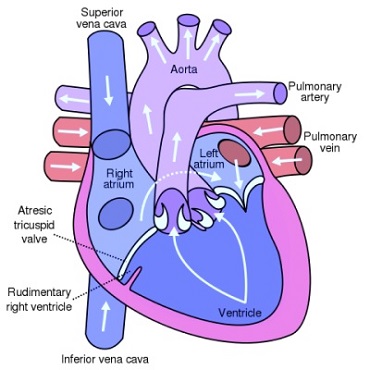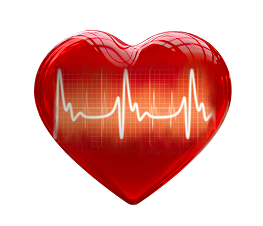Index
Tricuspid Atresia

What Is Tricuspid Atresia?
Tricuspid atresia is a form of congenital heart disease whereby there is a complete absence of the tricuspid valve.
Therefore, there is an absence of right atrioventricular connection. This leads to a hypoplastic (undersized) or absent right ventricle.
This defect is contracted during prenatal development when the heart does not finish developing. It causes the heart to be unable to properly oxygenate the rest of the blood in the body. Because of this, the body does not have enough oxygen to live, so other defects must occur to maintain blood flow. Because of the lack of an A-V connection, an atrial septal defect (ASD) must be present to fill the left ventricle with blood. Also, since there is a lack of a right ventricle there must be a way to pump blood into the pulmonary arteries, and this is accomplished by a ventricular septal defect (VSD). The causes of Tricuspid atresia are unknown.
An atrial septal defect (ASD) and a ventricular septal defect (VSD) must both be present to maintain blood flow-from the right atrium, the blood must flow through the ASD to the left atrium to the left ventricle and through the VSD to the right ventricle to allow access to the lungs.
This defect is contracted during prenatal development when the heart does not finish developing. It causes the heart to be unable to properly oxygenate the rest of the blood in the body. Because of this, the body does not have enough oxygen to live, so other defects must occur to maintain blood flow. Because of the lack of an A-V connection, an atrial septal defect (ASD) must be present to fill the left ventricle with blood. Also, since there is a lack of a right ventricle there must be a way to pump blood into the pulmonary arteries, and this is accomplished by a ventricular septal defect (VSD). The causes of Tricuspid atresia are unknown.
An atrial septal defect (ASD) and a ventricular septal defect (VSD) must both be present to maintain blood flow-from the right atrium, the blood must flow through the ASD to the left atrium to the left ventricle and through the VSD to the right ventricle to allow access to the lungs.
What Causes Tricuspid Atresia?
The causes of heart defects, such as tricuspid atresia, among most babies are unknown. Some babies have heart defects
because of changes in their genes or chromosomes. Heart defects also are thought to be caused by a combination of genes and other
factors, such as the things the mother comes in contact within the environment, or what the mother eats or drinks, or certain medicines she uses.
Tricuspid atresia happens when the heart forms early in pregnancy. No one knows why the valve does not grow normally.
Tricuspid atresia happens when the heart forms early in pregnancy. No one knows why the valve does not grow normally.

What are the Signs & Symptoms of
Tricuspid Atresia?
Tricuspid Atresia normally their symptoms become evident soon after birth, some of them are:
- Difficulty Breathing,
- Blue tinge to the skin and lips "Cyanosis",
- Slow growth and poor weight gain,
- Tiring easily, especially during feedings,
- Some babies or older people with Tricuspid Atresia also develop symptoms of heart failure, including:
- Shortness of breath,
- Fatigue and Weakness,
- Swelling of the abdomen (ascites),
- Swelling (edema) in the legs, ankles and feet,
- Sudden weight gain from fluid retention.
- Difficulty Breathing,
- Blue tinge to the skin and lips "Cyanosis",
- Slow growth and poor weight gain,
- Tiring easily, especially during feedings,
- Some babies or older people with Tricuspid Atresia also develop symptoms of heart failure, including:
- Shortness of breath,
- Fatigue and Weakness,
- Swelling of the abdomen (ascites),
- Swelling (edema) in the legs, ankles and feet,
- Sudden weight gain from fluid retention.
HEART CONDITIONS Diseases and Treated FAQ's
- CXR : Decreased pulmonary blood flow and oligemic lung field.
- ECG : Left Axis Deviation.
- Tricuspid Atresia may be diagnosed during pregnancy or soon after a baby is born.
- During Pregnancy.
- Tricuspid Atresia might be seen during an ultrasound (which creates pictures of the body). Some findings from the ultrasound may make the health care provider suspect that a baby might have tricuspid atresia. If so, the health care provider can request a fetal echocardiogram to confirm the diagnosis.
A fetal echocardiogram is an ultrasound specifically of the baby’s heart and major blood vessels that is performed during the pregnancy. This test can show problems with the structure of the heart and how the heart is working with this defect.
- After a Baby is Born.
- They may have a bluish looking skin color, called cyanosis, because their blood does not carry enough oxygen. Infants with tricuspid atresia can have additional symptoms such as:
- Problems Breathing.
- Ashen or Bluish Skin Color.
- Poor Feeding.
- Extreme Sleepiness.
- ECG : Left Axis Deviation.
- Tricuspid Atresia may be diagnosed during pregnancy or soon after a baby is born.
- During Pregnancy.
- Tricuspid Atresia might be seen during an ultrasound (which creates pictures of the body). Some findings from the ultrasound may make the health care provider suspect that a baby might have tricuspid atresia. If so, the health care provider can request a fetal echocardiogram to confirm the diagnosis.
A fetal echocardiogram is an ultrasound specifically of the baby’s heart and major blood vessels that is performed during the pregnancy. This test can show problems with the structure of the heart and how the heart is working with this defect.
- After a Baby is Born.
- They may have a bluish looking skin color, called cyanosis, because their blood does not carry enough oxygen. Infants with tricuspid atresia can have additional symptoms such as:
- Problems Breathing.
- Ashen or Bluish Skin Color.
- Poor Feeding.
- Extreme Sleepiness.
This condition is not treated unless there are other heart problems, symptoms,
or if the person had a stroke caused by a blood clot to the brain.
Treatment most often requires a procedure called cardiac catheterization,
which is performed by a trained cardiologist to permanently seal the PFO.
Open heart surgery is no longer used to treat this condition unless another surgery is being performed.
This disease is a congenital heart defect, such as tricuspid atresia. Several factors can increase the risks
of a baby when born with any Congenital Heart Defect, some of these defects can included:
- Mother's Obesity.
- Drinking Alcohol - during pregnancy.
- Smoking before and/or during pregnancy.
- Older Parental Age at Conception.
- A Parent who has a Congenital Heart Defect.
- A Mother who has poorly controlled "Diabetes".
- A Mother who had German Measles (Rubella) or another "Viral Illness" during early pregnancy.
- Use of some types of medications during pregnancy, such as the Acne drug Isotretinoin (Claravis, Amnesteem, others), some anti-seizure medications and some bipolar disorder medications.
- The presence of Down Syndrome, a genetic condition that results from an extra 21st Chromosome.
- Mother's Obesity.
- Drinking Alcohol - during pregnancy.
- Smoking before and/or during pregnancy.
- Older Parental Age at Conception.
- A Parent who has a Congenital Heart Defect.
- A Mother who has poorly controlled "Diabetes".
- A Mother who had German Measles (Rubella) or another "Viral Illness" during early pregnancy.
- Use of some types of medications during pregnancy, such as the Acne drug Isotretinoin (Claravis, Amnesteem, others), some anti-seizure medications and some bipolar disorder medications.
- The presence of Down Syndrome, a genetic condition that results from an extra 21st Chromosome.